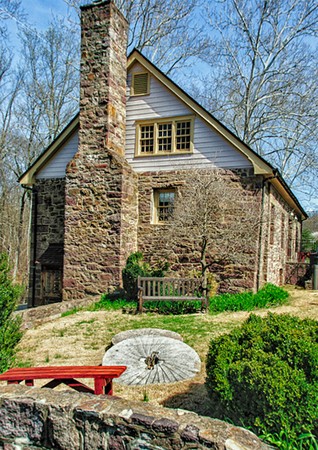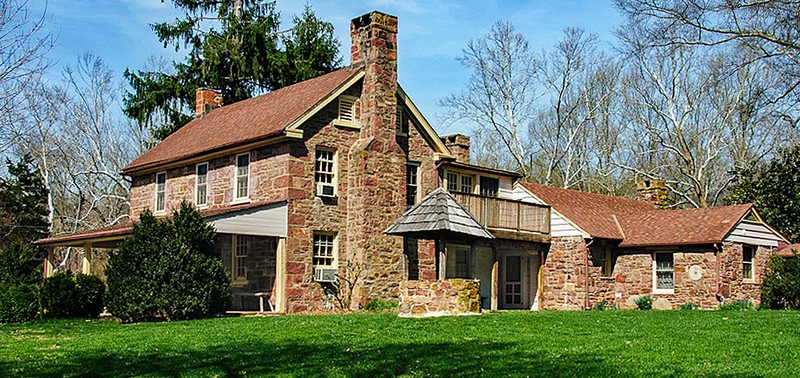Cabell's Mill and Miller's House/Middlegate
Introduction
Text-to-speech Audio
Images
Front Elevation of Cabell's Mill in 2012

Cabell Mill Miller's House, Middlegate, in 2012

Backstory and Context
Text-to-speech Audio
Cabell's Mill was built along Big Rocky Run around the 1770s by William Carr Lane; the miller's house was most likely constructed sometime in the early 1800s. The mill property was part of a land grant of 700 acres south of Big Rocky Run to Francis Awbrey in 1728. Initially used for grinding grains, the mill ground sumac for the tanning industry after the Civil War. The mill changed hands frequently for its first 80 years of operation. The property was advertised for sale in 1818 as "about 27 acres of land" with a "valuable merchant mill" and "a large stone dwelling house nearly finished" (the adjacent miller's house) within one mile of Centreville. The new owner in December 1818 was James Lane Triplett.
So, who was Cabell? The name is a misnomer, taken from a misspelling of the owner's name - Edward Caple - on a Civil War-era map. Caple bought what was known then as Triplett's Mill in 1845. Edward died in 1865; the mill on a 20-acre tract passed to his son, James S., with Edward's widow, Ruth, given life tenancy in the two west rooms of the dwelling house. Ruth Caple also was granted pasturage of one cow, would have her fuel cut and hauled, and would receive an annuity of $100 per year. In 1870, James S. was a 26-year-old miller, living in the miller's house with his wife, a two-year-old daughter, and a domestic servant. James S. Caple sold the mill property to Erasmus M. Pittman in 1875, ending his family's 30-year period of ownership. Pittman converted the operations to grinding sumac. The 2-1/2 story stone structure once had a 26-foot-tall overshot wheel on its eastern side. The walls of the first two stories are two feet thick!
New owners of the mill in 1908 described the saw and grist mill as running full time in 1909 under the supervision of a "first class miller." The mill's last operators were Harvey and Olive Nichols, who sold the property in 1916. Rocky Run was diverted and the mill race was filled in during renovations of the mill in 1929 by John Rixey-Smith. The following year, Rixey-Smith moved into his summer residence at the mill and constructed a dam to impound water for a swimming pool.
Now part of Ellanor C. Lawrence Park, a 650-acre nature-themed park of the Fairfax County Park Authority, the mill was converted into a guest house by the new owners, Ellanor C. and David Lawrence, in the mid-1940s. The Lawrences were residents of Washington, D.C. and initially used the property as a weekend retreat. The adjacent miller's house, called Middlegate by this time, was renovated by the Lawrences into their country residence. They added a wing constructed of stone connected to the main house by a breezeway in 1944. After Mr. Lawrence retired, the couple settled at Middlegate.
David Lawrence was the founder of U.S. News and World Report. He recorded weekly newscasts, broadcast on the NBC Network, from the property from 1945 to 1970. After Mrs. Lawrence died, Mr. Lawrence donated the property to Fairfax County to be used as a park. The mill served as a local Community Center in the 1970s. After major renovations of the interior of the mill by the county in 1980, the mill was made available for event rentals. The miller's house, Middlegate, is used by the Fairfax County Park Authority staff and is not open to the public.
Cabell's Mill and Middlegate are listed on the Fairfax County Inventory of Historic Sites.
Sources
Ellanor C. Lawrence Park, Middlegate and Cabell's Mill; Ellanor C. Lawrence Park; Park Authority, Fairfax County Virginia. Accessed June 6th 2020. https://www.fairfaxcounty.gov/parks/eclawrence/middlegate-cabells.
Fairfax County Deed Books, Fairfax, Virginia.
Netherton, Mrs. Ross D. (Nan). Fairfax County Historic Landmarks Survey form for Cabell's Mill. 1970.
Northern Neck Land Proprietary Records.
"Notice." Fairfax Herald (Fairfax, VA) May 26th 1909, 3-3.
Repetti, Cheryl-Ann Beattie. Cabell's Mill Chain of Key Events. Manuscript prepared for Fairfax County Park Authority [FCPA], Annandale, VA. 2011.
"Untitled, re: work at mill by John Rixey-Smith." Herndon Observer (Herndon, VA) August 8th 1929, 1-1.
"Untitled, re: work on pool by John Rixey-Smith." Herndon Observer (Herndon, VA) April 26th 1930, 2-2.
U.S. Census of Industrial Products 1880
U.S. Population Census 1870
"Untitled, advertisement of land at public sale." Palladium of Liberty (Unknown) October 30th 1818.
Versar, Inc. and ABL Landscape Architecture. Ellanor C. Lawrence Park, Cultural Landscape Report. Springfield, VA. 2015.
Worthington, George. Historic American Buildings Survey Inventory, Cabell's Mill. 1958.
E. C. Lawrence Park website, Fairfax County Park Authority [FCPA]
E. C. Lawrence Park website, FCPA
